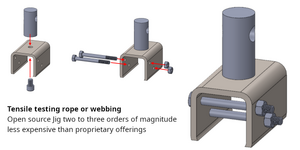
Alternative food sources are essential in both low-resource settings and during emergencies like abrupt sunlight reduction scenarios. Seaweed presents a promising option but requires investigation into the viability of unconventionally sourced ropes for harvesting. In this regard, a low-cost reliable method to test the tensile strength of rope is needed to validate alternative materials for use in harvesting seaweed. Commercial rope testing jigs alone range in price from several thousand to tens of thousands of dollars, so there is interest in developing a lower-cost alternative. Addressing these needs, this article reports on an open-source design for tensile strength rope testing hardware. The hardware design focuses on using readily available parts that can be both sourced from a hardware store and manufactured with simple tools to provide the greatest geographic accessibility. The jig design, which can be fabricated for CAD 20, is two to three orders of magnitude less expensive than commercially available solutions. The jig was built and tested using a case study example investigating denim materials (of 1 5/8”, 3 1/4”, 4 7/8”, 6 1/2”, and 8 1/8” widths) as a potential alternative rope material for seaweed farming. Denim demonstrated strengths of up to 1.65 kN for the widest sample, and the jig demonstrated sufficient strength and stiffness for operations at forces below 4 kN. The results are discussed and areas for future improvements are outlined to adapt the device to other circumstances and increase the strength of materials that can be tested.




